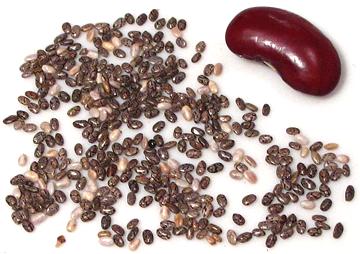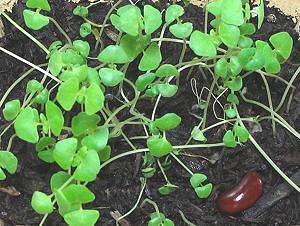Chia

[Tokhm-e Sharbati (Persia - lit Sharbati Seed); Salvia hispanica]
Native to Mexico and Guatemala, chia seed was the third most important
crop of the Aztecs, after corn and beans and ahead of amaranth.
It is not a grain, but seed of a member of the Sage genus
(Salvia) in the Mint Family (Lamiaceae). It is
highly nutritious and gluten free, with a high protein content, and
is very rich in omega-3 fatty acids, antioxidants, and dietary fiber.
Today the leading producer is Australia, followed by Mexico,
Bolivia, Argentina, Ecuador and Guatemala.
North of the Mexican border the main use of chia seed has been for
the green fur on Chia Pets, but it has started to penetrate the Health
Food and Ethnic Foods markets. In Persia (Iran) it is now used in
Sharbati (cooling soft drinks), alone or in combination with the
traditional London Rocket seeds.
Chia sprouts are edible and used similarly to alfalfa sprouts. Food
manufacturers are now experimenting with replacement of as much as
25% of the egg and oil in cakes with a gel made from chia.
More on Sage.
 This seed has long been used whole in beverages, because, like the
Basil seeds popular in Thailand, it absorbs about 12 times its weight
in liquid, producing a gelatinous effect. Chia can be easily sprouted,
and the sprouts used similarly to alfalfa sprouts. You have to plant
a zillion of them because they are so small. Yes, that's our infamous
kidney bean at the lower right of the photo to the left.
This seed has long been used whole in beverages, because, like the
Basil seeds popular in Thailand, it absorbs about 12 times its weight
in liquid, producing a gelatinous effect. Chia can be easily sprouted,
and the sprouts used similarly to alfalfa sprouts. You have to plant
a zillion of them because they are so small. Yes, that's our infamous
kidney bean at the lower right of the photo to the left.
Buying:
These are now easy to find in ethnic, health
food and yuppie oriented markets - but pricing is all over the map.
The photo specimens were purchased from the spices section of a large
multi-ethnic market in Los Angeles, packed in 8 ounce bags at 2016 US
$5.98 / pound.
Storing:
In an airtight container, kept away from heat
and light, it should be good for at least 6 months.
Using:
For Sharbat-e Khakshir the seeds are used
whole, along with traditional Khakshir seeds, mixed with water,
a little sugar, a dash of rosewater, perhaps herbs, and lots of ice.
Let it sit until the gel forms.
Health & Nutrition:
Chia seeds are
outstandingly nutritious. They have a good spread of proteins, and a very
significant Omega-3 oil content. They are also rich in B vitamins,
thiamine, and niacin, as well as a good source of riboflavin and folate.
They are also a rich source of minerals, particularly calcium, iron,
magnesium, manganese, phosphorus, and zinc. Research into specific health
benefits is still in the preliminary stages, but so far no significant
influence on cardiovascular health has been demonstrated.
mt_chiaz 160311 - www.clovegarden.com
©Andrew Grygus - agryg@clovegarden.com - Photos on this
page not otherwise credited are © cg1 -
Linking to and non-commercial use of this page permitted
 This seed has long been used whole in beverages, because, like the
Basil seeds popular in Thailand, it absorbs about 12 times its weight
in liquid, producing a gelatinous effect. Chia can be easily sprouted,
and the sprouts used similarly to alfalfa sprouts. You have to plant
a zillion of them because they are so small. Yes, that's our infamous
kidney bean at the lower right of the photo to the left.
This seed has long been used whole in beverages, because, like the
Basil seeds popular in Thailand, it absorbs about 12 times its weight
in liquid, producing a gelatinous effect. Chia can be easily sprouted,
and the sprouts used similarly to alfalfa sprouts. You have to plant
a zillion of them because they are so small. Yes, that's our infamous
kidney bean at the lower right of the photo to the left.
